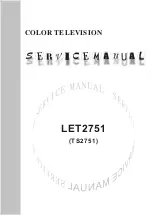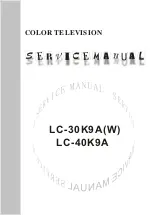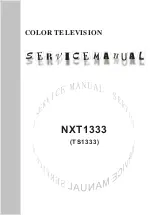
Service Modes, Error Codes, and Fault Finding
5.
5.9.6
Display option code
Caution:
In case you have replaced the SSB, always check the
display option code in SAM, even if you have picture. With a
wrong display option code it is possible that you have picture,
but that in certain conditions you have unwanted side-effects.
5.9.7
Upgrade EDID NVM
To upgrade the EDID NVM you must short circuit pin 7 of the
EDID NVM to ground. Therefore some test points are foreseen
next to the HDMI connectors (see figure
and
). See section
for further instructions.
Figure 5-14 EDID-NVM pins HDMI-rear
Figure 5-15 EDID-NVM pins HDMI-side
5.10 Software Upgrading
5.10.1 Introduction
The set software and security keys are stored in a NAND-
Flash, which is connected to the PNX85xx via the PCI bus.
It is possible
for the user
to upgrade the
main
software via the
USB port. This allows replacement of a software image in a
stand alone set, without the need of an E-JTAG debugger. A
description on how to upgrade the main software can be found
in the DFU.
Important:
When the NAND-Flash must be replaced, a new
SSB must be ordered, due to the presence of the security
keys!!! (copy protection keys, MAC address, ...).
Perform the following actions after SSB replacement:
1.
Set the correct option codes (see sticker inside the TV).
2.
Update the TV software (see the DFU for instructions).
3.
Perform the alignments as described in chapter 8 (section
“Reset of Repaired SSB”).
4.
Check in CSM if the HDMI keys are valid.
5.10.2 Main Software Upgrade
The software image resides in the NAND-Flash, and is
formatted in the following way (refer to next figure):
Table 5-3 NAND flash content
•
The above overview of the NAND Flash shows the content
of the different partitions. It also shows which part of the
one-zip file erases and programs which part of the NAND
Flash.
•
Remark: the above does not mean that you can reprogram
your HDMI keys with the “UpgradeAll.upg” file from the one
zip file. This can only be done in a secure environment (e.g.
the factory).
•
The “UpgradeAll.upg” file is
only
used in the factory.
•
The “FlashUtils.upg” file is only used by service centra
which are allowed to do component level repair on the
SSB.
H_17650_0
8
9.ep
s
16010
8
EDID
3
EDID 2
EDID 1
1
8
6
8
0_202_090
8
25.ep
s
090
8
25
EDID
s
ide
NAND Flash content
One ZIP
Fuse UPG
Upgrade all UPG
Flash Utils UPG
Partition
Content
Erase
Program Erase
Program Erase
Program
JFFS2 partition 1 (application read write data)
Channel table, EPG data,...
X
X
X
JFFS2 partition 0 (Application read only once data)
HDMI keys, back up display file, …
X
X
JFFS2 partition 0 (Application read only upgradable data) wizard pictures, display file, cabinet file, upgrade assistant, …
X
X
X
SQUASHFS partition
Main software (MIPS), Linux structure (root file system)
X
X
X
X
BFFS partition 2 (DVD OK)
Default software upgrade application TriMedia software boot
batch file 2
X
X
X
X
BFFS partition 1 (DVD cursor down)
Back up software upgrade application boot batch file 1
Linux kernel JETT: needed for ComPair
X
X
X
X
BFFS partition 0
Jaguar Boot loader boot batch file 0
X
X
Block 0
mBTM partition table
X
















































